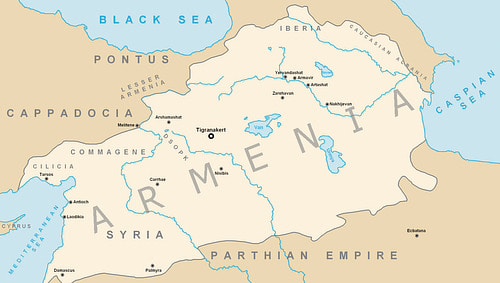In the Hellenistic royal city of Artashat-Artaxata
Archaeologists from the University of Münster and the National Academy of Sciences of the Republic of Armenia have discovered remains of a Roman arched aqueduct during excavation work on the Hellenistic royal city of Artashat-Artaxata in ancient Armenia. It is the easternmost arched aqueduct in the Roman Empire. Excavation work took place back in 2019, and an evaluation of the find has now been published in the “Archäologischer Anzeiger” journal.
“The monumental foundations are evidence of an unfinished aqueduct bridge built by the Roman army between 114 and 117 CE,” explains author Prof. Achim Lichtenberger from the Institute of Classical Archaeology and Christian Archaeology at the University of Münster.
“At that time, Artaxata was destined to become the capital of a Roman province in Armenia.” It was during this time that the Roman Empire reached its greatest extent – if only for a short while – because it was under Trajan, who was Emperor of Rome from 98 to 117 CE – that the Romans attempted to incorporate the province of Armenia into the Roman Empire.
“The planned, and partially completed, construction of the aqueduct in Artaxata shows just how much effort was made, in a very short space of time, to integrate the infrastructure of the capital of the province into the Empire,” says co-author Torben Schreiber from the Institute of Classical Archaeology and Christian Archaeology at the University of Münster.
“The aqueduct remained unfinished because after Trajan’s death, in 117 CE, his successor Hadrian relinquished the province of Armenia before the aqueduct was completed.” The archaeologists, therefore, see their find as furnishing evidence for the failure of Roman imperialism in Armenia.

Artashat (aka Artaxata) was the capital of Ancient Armenia from 176 BCE and remained so for over 300 years of the kingdom's history.

Artashat was the first Armenian city to be built according to Hellenistic planning, and it eventually became the largest city yet built on the Plain of Ararat. The city's fine features are listed here by the historian R. G. Hovannisian:
The city contained a citadel on the height later called Xor Virap (Khor Virap) and was protected by extensive fortifications and a moat. Recent excavations have a revealed a major urban center with paved streets, public buildings, baths, shops, and workshops of various craftsmen…it rapidly became a major junction point between the trade route along the valley of the Araxes leading outward to Bactriaand India and the one running northward to the Black Sea. (49)
Artaxias was said to have adorned the city with fine bronze statues of Greek gods such as Zeus, Artemis, Apollo, and Hercules. The city's Greek and Persian cultural mix is attested by archaeological finds of Greek figurines and clay plaques with depictions of Iranian horse riders.
UNIVERSITY OF MÜNSTER
Header Image – The excavation section shows a pillar of the unfinished aqueduct – Image Credit: Artaxata project


